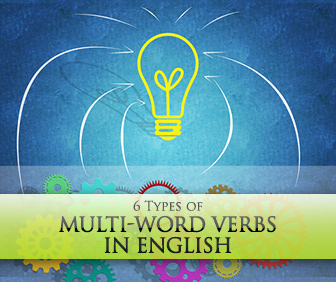Verbs are a straightforward element of the English language, aren’t they? Every sentence needs one, and they come right after the subject. Things can get complicated, though, and do when more than one word makes up a verb in English.
These word combinations, commonly called phrasal verbs, can confuse ESL students even when they know that verb combinations like these exist. To help clarify things for your students, here are explanations and examples of six types of multi-word verbs in English.

6 Types of Multi-Word Verbs in English
-
1
Verb + Preposition (Verbs followed by a preposition)
We start our discussion of multiword verbs with an exception. Just because a verb is followed by a preposition, it does not make it a phrasal verb. Though it may be misleading, some verbs that are followed by a preposition are not phrasal verbs at all. This can be confusing for ESL students. In the following example, a preposition follows the verb and gives additional information to the sentence. This preposition, however, is not essential to the meaning of the verb, that is including it in the sentence does not change the base meaning of the verb. One could just as easily replace the prepositional phrase with another word without changing the core meaning of the sentence. In contrast, consider the second example. In this case, the combination of the verb and the preposition (look up) means to research. It does not mean the physical action of the eyes (look). This preposition does change the meaning of the verb, and therefore “look up” is a true phrasal verb and not just a verb followed by a preposition.
- I sat on the couch.
- I sat there.
- I looked up a word in the dictionary.
- I looked at a word in the dictionary.
-
2
Verb + Preposition (Inseparable Phrasal Verbs)
Some verbs that are followed by a preposition cannot be separated from that preposition without losing the meaning of the verb. In the example below, though the verb + preposition + noun looks similar to the example above, the underlying make up of this verb is very different. The preposition over is essential to the meaning of this verb, and changing it or removing it changes the meaning of the verb itself. In addition, for this type of phrasal verb the preposition cannot be separated from the verb by the object.
- The girl got over the breakup.
- The girl got into the breakup.
- The girl got the breakup.
- Wrong: The girl got the breakup over.
-
3
Verb + Preposition (Separable Phrasal Verbs)
A third verb-preposition combination looks similar to the previous two, but separable phrasal verbs can act quite differently in a sentence. Similar to inseparable phrasal verbs, the preposition combined with the verb changes the meaning of the base verb. Changing or removing the preposition changes the meaning of the verb. Unlike the other phrasal verbs, though, the preposition can appear after the object of the verb without changing the meaning of the sentence.
- The teacher looked over the exams.
- The teacher looked at the exams.
- The teacher looked.
- The teacher looked the exams over.
-
4
Intransitive Verb + Participle/Adverb (Intransitive Verbs followed by a participle/adverb)
Though they are often lumped in with phrasal verbs, the combination of a verb with a participle or adverb is actually different from those we have already talked about. In this case, the participle or adverb which follows the verb gives additional, not different, meaning to the verb in the sentence. Changing the participle does change the meaning of the sentence, but the base meaning of the verb remains the same. In addition, the participle can be removed without changing the meaning of the verb.
- The woman looked up.
- The woman looked down.
- The woman looked.
-
5
Intransitive Verb + Participle/Adverb (Intransitive Phrasal Verbs)
Though these verb + participle combinations may look like those in the previous section, in intransitive phrasal verbs, the participle/adverb following the verb changes the meaning of the verb itself. Like separable and inseparable phrasal verbs, the participle/adverb cannot be changed or omitted without changing the meaning of the verb. Though this type of multi-word verb can be followed by an adverb, that adverb cannot be placed between the verb and its participle/adverb.
- The plane took off.
- The plane took over.
- Wrong: The plane took.
- The plane took off late.
- Wrong: The plane took late off.
-
6
Verb + Preposition + Preposition (Phrasal-Prepositional Verbs)
Though the combination of a verb + a preposition + a preposition may seem grammatically impossible, it can happen when the preposition is a part of a phrasal verb. In this case, the prepositions change the base meaning of the verb and cannot be separated from it in the sentence. Omitting either preposition changes the meaning of the verb or results in an ungrammatical sentence. Even advanced students may have trouble recognizing and using phrasal prepositional verbs, but making them aware of this grammatical combination is the first step in using them correctly.
- I will catch up with you later.
- I will catch up later.
- I will catch you later.
- Wrong: I will catch with you later.
Different teachers use different labels for each of these verb types. Ultimately, it’s not the label that matters.
As long as your students can recognize what type of verb appears in a sentence and when more than one word makes up that verb, they will have a good understanding of its meaning.
How soon into your curriculum do students start asking about phrasal verbs?
P.S. If you enjoyed this article, please help spread it by clicking one of those sharing buttons below. And if you are interested in more, you should follow our Facebook page where we share more about creative, non-boring ways to teach English.







